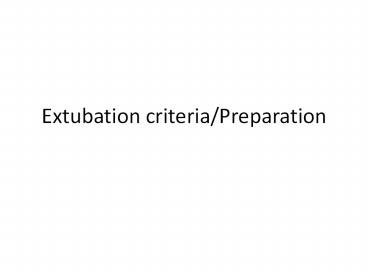Weaning and Extubation - PowerPoint PPT Presentation
Title:
Weaning and Extubation
Description:
weaning and extubation – PowerPoint PPT presentation
Number of Views:566
Title: Weaning and Extubation
1
Extubation criteria/Preparation
2
Weaning
- The transition from ventilatory support to
completely spontaneous breathing,during which
time the patient assumes the responsibility for
effective gas exchange whilepositive pressure
support is withdrawn.
3
Extubation
- Criteria for extubation include1. spontaneous
ventilation, hemodynamic stability, intact - airway reflexes, and manageable airway
secretions. - 2. Success is defined as 48 hours of
spontaneous - breathing without positive pressure
support. - 3. Early extubation failure is defined as
that which occurs - within 6 hours of extubation
intermediate extubation - failure is that which occurs from 6 to
24 hours of - extubation
4
Spontaneous Breathing Test (SBT
- When purpose of Ventilating the patient achieved
- underlying disease process necessitating
mechanical ventilation has improved sufficiently - To allow the patient adequate gas exchange with
spontaneous breathing. - Usually mode is changed to PSV
5
Spontaneous Breathing Test (SBT
- In a study by Esteban et al., 2-hour trials of
unassisted breathing using PS of 7 cmH2O were
compared to T-piece alone. - More patients in the PS group tolerated the trial
and were extubated at the end of the trial than
the T-piece group (86 vs. 78) - There was no difference in the rate of
reintubation. - A second similar study by Esteban et al., also
showed no difference in reintubation rates
between groups. However, the shorter T-piece
trial benefited patients by reducing ICU and
hospital duration (2 days and 5 days shorter,
respectively).
6
Extubation Readiness Test (ERT)
- is a formal trial of spontaneous breathing to
evaluate readiness for dc of the ETT and/or
ventilatory support. - assessing Neurologically after stopping sedations
Adequate muscle strength - NBM for gt 4 hours
- Awake or easily roused
- Work of breathing acceptable on PS 10/5
- Good respiratory effort on T-piece
- Latest CXR reviewed
- Haemodynamically stable
- No residual muscle relaxation
- Good cough reflex on tracheal suctioning
- Leak test
7
Other Parameters for readiness
- Adequate oxygenation (P/F ratio)
- HB and Temparature
- Normal acid base status no significant
respiratory acidosis - PEEP less than 8 cmH2O
- Satisfactory tidal volume VT gt 5ml/kg
- Satisfactory vital capacity VC gt 10ml/kg
- Satisfactory MIP less than 20-25 cmH2O (i.e
pressure trigger) - Satisfactory RSBI an fR/VT less than 105
8
Criteria for Failure During 2 Hours on CPAP lt 5
cmH2O or T-piece
- Clinical Criteria
- Diaphoresis
- Nasal flaring
- Increasing respiratory effort
- Tachycardia (increase in HR gt 40 bpm)
- Cardiac arrhythmias
- Hypotension
- Apnea
- Laboratory Criteria
- Increase of PetCO2 gt 10 mmHg
- Decrease of arterial pH lt 7.32
- PaO2 lt 60mmHg with an FiO2 gt 0.40 (P/F O2 ratio lt
150) - SpO2 declines gt 5
9
Equipment to be Ready before Extubation
- Equipment
- Check oxygen sources
- Working Ambubag
- Suction system ready
- Appropriate sized mask Appropriate size syringe
to deflate cuff. - Capnography if avaiable
- Intubation trolley
- Laryngoscope and working different size of
blades - Bougie/stylet
- ETT (cuffed and uncuffed) correct sizes
- ET tie/Tape
- Drugs(Ventolin in case of spasm,Pulmicart,resmic
epinephrine,Atrovent,Normal sline) - Adrenalin Atropine in case of Vasovagal
stimulation.
10
Assess Readiness
- Known difficult airway? If yes, clarify plan with
Consultant Extubation plan Nasal cannula/High
Flow Nasal Oxygen CPAP/BiPAP
11
Ventilator Free Days (VFD)
- is an outcome measure consisting of the number of
days in a given time period. - Successful discontinuation of ventilator support
requires a minimum of 48 hourswithout positive
pressure ventilation. - Patients who die are considered to have
zeroventilator free days.
12
Management of post extubation stridor
- Manual CPAP
- High Flow Nasal Oxygen
- Mask CPAP/BiPAP
- Consider re-intubation
- DRUGS Dexamethasone 0.5mg/kg IV then 0.2mg/kg IV
6 hourly for 24 hours Nebulised 11000 adrenaline
0.4ml/kg (MAX 5mls) dilute to final volume of 5
mls
13
Croup score specialy for pediatric
Dr. Terry Klassen
14
Thanks
- Shams Ali Shah
- RT at PSCCQ






























